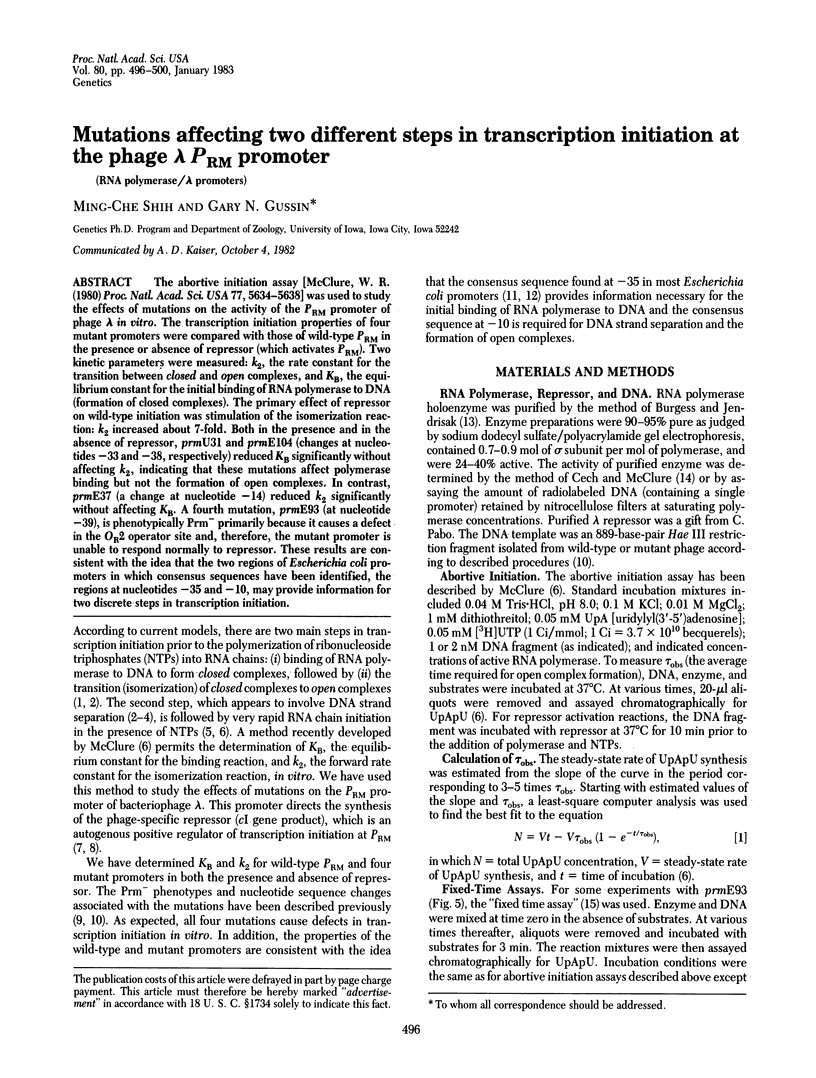Mutations affecting two different steps in transcription initiation at the phage λ PRM promoter (original) (raw)
Abstract
The abortive initiation assay [McClure, W. R. (1980) Proc. Natl. Acad. Sci. USA 77, 5634-5638] was used to study the effects of mutations on the activity of the _P_RM promoter of phage λ in vitro. The transcription initiation properties of four mutant promoters were compared with those of wild-type _P_RM in the presence or absence of repressor (which activates _P_RM). Two kinetic parameters were measured: _k_2, the rate constant for the transition between closed and open complexes, and _K_B, the equilibrium constant for the initial binding of RNA polymerase to DNA (formation of closed complexes). The primary effect of repressor on wild-type initiation was stimulation of the isomerization reaction: _k_2 increased about 7-fold. Both in the presence and in the absence of repressor, _prm_U31 and _prm_E104 (changes at nucleotides -33 and -38, respectively) reduced _K_B significantly without affecting _k_2, indicating that these mutations affect polymerase binding but not the formation of open complexes. In contrast, _prm_E37 (a change at nucleotide -14) reduced _k_2 significantly without affecting _K_B. A fourth mutation, _prm_E93 (at nucleotide -39), is phenotypically Prm- primarily because it causes a defect in the _O_B2 operator site and, therefore, the mutant promoter is unable to respond normally to repressor. These results are consistent with the idea that the two regions of Escherichia coli promoters in which consensus sequences have been identified, the regions at nucleotides -35 and -10, may provide information for two discrete steps in transcription initiation.
Keywords: RNA polymerase, λ promoters

Selected References
These references are in PubMed. This may not be the complete list of references from this article.
- Burgess R. R., Jendrisak J. J. A procedure for the rapid, large-scall purification of Escherichia coli DNA-dependent RNA polymerase involving Polymin P precipitation and DNA-cellulose chromatography. Biochemistry. 1975 Oct 21;14(21):4634–4638. doi: 10.1021/bi00692a011. [DOI] [PubMed] [Google Scholar]
- Cech C. L., McClure W. R. Characterization of ribonucleic acid polymerase-T7 promoter binary complexes. Biochemistry. 1980 May 27;19(11):2440–2447. doi: 10.1021/bi00552a023. [DOI] [PubMed] [Google Scholar]
- Chamberlin M. J. The selectivity of transcription. Annu Rev Biochem. 1974;43(0):721–775. doi: 10.1146/annurev.bi.43.070174.003445. [DOI] [PubMed] [Google Scholar]
- Hawley D. K., McClure W. R. In vitro comparison of initiation properties of bacteriophage lambda wild-type PR and x3 mutant promoters. Proc Natl Acad Sci U S A. 1980 Nov;77(11):6381–6385. doi: 10.1073/pnas.77.11.6381. [DOI] [PMC free article] [PubMed] [Google Scholar]
- Hawley D. K., McClure W. R. Mechanism of activation of transcription initiation from the lambda PRM promoter. J Mol Biol. 1982 May 25;157(3):493–525. doi: 10.1016/0022-2836(82)90473-9. [DOI] [PubMed] [Google Scholar]
- Johnson A. D., Meyer B. J., Ptashne M. Interactions between DNA-bound repressors govern regulation by the lambda phage repressor. Proc Natl Acad Sci U S A. 1979 Oct;76(10):5061–5065. doi: 10.1073/pnas.76.10.5061. [DOI] [PMC free article] [PubMed] [Google Scholar]
- Mangel W. F., Chamberlin M. J. Studies of ribonucleic acid chain initiation by Escherichia coli ribonucleic acid polymerase bound to T7 deoxyribonucleic acid. 3. The effect of temperature on ribonucleic acid chain initiation and on the conformation of binary complexes. J Biol Chem. 1974 May 25;249(10):3007–3013. [PubMed] [Google Scholar]
- Mangel W. F., Chamberlin M. J. Studies of ribonucleic acid chain initiation by Escherichia coli ribonucleic acid polymerase bound to T7 deoxyribonucleic acid. I. An assay for the rate and extent of ribonucleic acid chain initiation. J Biol Chem. 1974 May 25;249(10):2995–3001. [PubMed] [Google Scholar]
- McClure W. R. Rate-limiting steps in RNA chain initiation. Proc Natl Acad Sci U S A. 1980 Oct;77(10):5634–5638. doi: 10.1073/pnas.77.10.5634. [DOI] [PMC free article] [PubMed] [Google Scholar]
- Meyer B. J., Ptashne M. Gene regulation at the right operator (OR) of bacteriophage lambda. III. lambda repressor directly activates gene transcription. J Mol Biol. 1980 May 15;139(2):195–205. doi: 10.1016/0022-2836(80)90304-6. [DOI] [PubMed] [Google Scholar]
- Ptashne M., Backman K., Humayun M. Z., Jeffrey A., Maurer R., Meyer B., Sauer R. T. Autoregulation and function of a repressor in bacteriophage lambda. Science. 1976 Oct 8;194(4261):156–161. doi: 10.1126/science.959843. [DOI] [PubMed] [Google Scholar]
- Rosen E. D., Gussin G. N. Clustering of Prm- mutations of bacteriophage lambda in the region between 33 and 40 nucleotides from the cL transcription start point. Virology. 1979 Oct 30;98(2):393–410. doi: 10.1016/0042-6822(79)90562-2. [DOI] [PubMed] [Google Scholar]
- Rosen E. D., Hartley J. L., Matz K., Nichols B. P., Young K. M., Donelson J. E., Gussin G. N. DNA sequence analysis of prm-mutations of coliphage lambda. Gene. 1980 Nov;11(3-4):197–205. doi: 10.1016/0378-1119(80)90060-8. [DOI] [PubMed] [Google Scholar]
- Rosenberg M., Court D. Regulatory sequences involved in the promotion and termination of RNA transcription. Annu Rev Genet. 1979;13:319–353. doi: 10.1146/annurev.ge.13.120179.001535. [DOI] [PubMed] [Google Scholar]
- Rosenberg S., Kadesch T. R., Chamberlin M. J. Binding of Escherichia coli RNA polymerase holoenzyme to bacteriophage T7 DNA. Measurements of the rate of open complex formation at T7 promoter A. J Mol Biol. 1982 Feb 15;155(1):31–51. doi: 10.1016/0022-2836(82)90490-9. [DOI] [PubMed] [Google Scholar]
- Siebenlist U. RNA polymerase unwinds an 11-base pair segment of a phage T7 promoter. Nature. 1979 Jun 14;279(5714):651–652. doi: 10.1038/279651a0. [DOI] [PubMed] [Google Scholar]
- Siebenlist U., Simpson R. B., Gilbert W. E. coli RNA polymerase interacts homologously with two different promoters. Cell. 1980 Jun;20(2):269–281. doi: 10.1016/0092-8674(80)90613-3. [DOI] [PubMed] [Google Scholar]